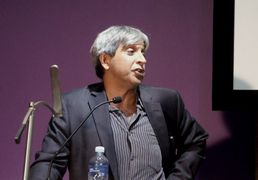ARE public sector workers a new labour elite in SA? Yes, according to researchers at the Development Policy Research Unit (DPRU) of the University of Cape Town. Their position is not new, though.
The Democratic Alliance and other commentators have been saying for years that the public sector is overstaffed and overpaid. If this belief were taken to heart and implemented, the result would be a disaster, not only for public sector workers, but for the entire working class, including the unemployed.
The DPRU researchers explain that public sector employment has grown both in numbers and as a proportion of the total number of employees in SA. The implication is that the sheer growth in numbers is evidence that these workers constitute a labour elite. This is nonsensical.
It might make sense if people are given public sector jobs that serve no other purpose other than paying them wages. But that would be hard to argue for, even for the most committed neoliberal propagandists.
The truth is that public sector workers are overwhelmed. Measured against the scale of their tasks, the sector is understaffed. From garbage collectors to doctors, they are nowhere close to satisfying even the most basic needs of the citizens who use their services.
The next element of the "labour elite" concept of the DPRU researchers concerns the positions and identities of the workers. They note that the growth in the number of public sector workers has been biggest in the category of unskilled workers such as labourers employed through the government’s Expanded Public Works Programme (EPWP).
New jobs in the medium-skilled category were also major contributors, while some new jobs were also created in the highly skilled category. So, how does growth dominated by unskilled labourers in the EPWP mean that public sector workers constitute a labour elite?
The minimum wage legislated for EPWP workers in 2012 was R63 a day, which makes them among the lowest-paid workers in SA, earning even less than farm and domestic workers.
Next, the researchers note, that a higher percentage of women and Africans are employed in the public sector compared to the private sector. But black women in SA are not an elite — they are at the bottom of the social hierarchy.
The researchers cite union membership and its associated wage premium, which refers to how much more union members earn compared to nonunion members.
They say union density among public sector workers increased significantly, while declining significantly among private sector workers. But surely, the mere fact of belonging to a union cannot be taken as evidence that a worker is a member of a labour elite? Belonging to a union is a right South Africans enjoy. It could be argued that there are social, political and economic factors that render this right meaningless for private sector workers, which means public sector employees have an elite right to belong to unions.
...
BUT the DPRU researchers are not arguing this, and their point about union density does not contribute to their argument that public sector workers constitute a labour elite.
They note that the average wage of a public sector worker is about R4,000 more per month than that of a private sector worker, and there is less wage inequality in the public sector. This is the sum total of the evidence advanced that the labour market is segmented in a way that means public sector workers in unions and bargain councils constitute a labour elite.
They write that "members of private and public bargaining councils not belonging to unions earned an 8.97% and 10.5% premium over nonunion workers outside of the bargaining council system". This indicates that the real segmentation is not between the public and private sectors, but between those inside and outside bargaining councils.
Yes, "for unionised workers, the public sector wage premium is 20.7%", but this can be explained if we take into account how processes such as outsourcing, casualisation and labour broking affected public sector and private sector workers differently.
It is perhaps best to understand this by means of an example of a typical public sector workplace, such as a hospital. In the early 1990s, union membership would have been low and the majority of workers would have been low-earning cleaners, gardeners and general workers. The higher earners such as medical professionals and managers would not have been union members.
From the mid-1990s, the government implemented the Growth, Employment and Redistribution economic policy, which resulted in jobs for "noncore" workers such, as cleaners and gardeners, being cut. These workers joined the private sector through outsourcing and labour broking and very few of them could afford union membership.
At the same time, higher earners such as nurses, doctors and even hospital managers joined the public sector unions in large numbers. They, indeed, constitute an elite with regard to income and status compared to the cleaners and gardeners who work alongside them.
But do doctors, nurses and managers in the public sector earn more than their private sector counterparts? They do not.
During this period, outsourcing, casualisation and labour broking were almost universally implemented in the private sector as well. Although it had the same effects as in the public sector, in that it drove the targeted workers out of unions and bargaining councils and lowered their wages and job security, it did not drive the workers out of the private sector.
Union membership in the private sector declined, inequality increased, and real wages dropped. But this does not mean public sector workers constitute an elite.
If we pull out the private sector equivalents to the nurses, doctors and (yes) members of parliament that went into the calculations of the DPRU researchers, then these private sector high earners will also appear to be an elite.
...
THIS shows that the real labour segmentation is between the upper strata of unionised members of bargaining councils in both the private and public sectors on the one hand, and outsourced, casualised and labour-brokered workers in both sectors.
What are some of the political implications of this debate? The DPRU research, despite the weakness of its evidence and logic, should be taken seriously.
The strength of neoliberalism has never been in the academic quality of its arguments, but in the fact that it conforms to the interests of the real elites — the giant corporations and their allied politicians.
Right now in SA, an intensive attack on public services is being prepared. This anti-public servant narrative is really about discrediting and attacking public services in order to direct even more public resources in support of private profit. It is, therefore, not only an attack on public sector workers, but an attack on the entire working class.
• Wesso is research and policy lead at Oxfam South Africa

Contrary to recent research, it could be argued that there is nothing elite about SA’s understaffed and underpaid public sector workforce — in fact, they might be facing attack. Picture: SUNDAY TIMES
ARE public sector workers a new labour elite in SA? Yes, according to researchers at the Development Policy Research Unit (DPRU) of the University of Cape Town. Their position is not new, though.
The Democratic Alliance and other commentators have been saying for years that the public sector is overstaffed and overpaid. If this belief were taken to heart and implemented, the result would be a disaster, not only for public sector workers, but for the entire working class, including the unemployed.
The DPRU researchers explain that public sector employment has grown both in numbers and as a proportion of the total number of employees in SA. The implication is that the sheer growth in numbers is evidence that these workers constitute a labour elite. This is nonsensical.
It might make sense if people are given public sector jobs that serve no other purpose other than paying them wages. But that would be hard to argue for, even for the most committed neoliberal propagandists.
The truth is that public sector workers are overwhelmed. Measured against the scale of their tasks, the sector is understaffed. From garbage collectors to doctors, they are nowhere close to satisfying even the most basic needs of the citizens who use their services.
The next element of the "labour elite" concept of the DPRU researchers concerns the positions and identities of the workers. They note that the growth in the number of public sector workers has been biggest in the category of unskilled workers such as labourers employed through the government’s Expanded Public Works Programme (EPWP).
New jobs in the medium-skilled category were also major contributors, while some new jobs were also created in the highly skilled category. So, how does growth dominated by unskilled labourers in the EPWP mean that public sector workers constitute a labour elite?
The minimum wage legislated for EPWP workers in 2012 was R63 a day, which makes them among the lowest-paid workers in SA, earning even less than farm and domestic workers.
Next, the researchers note, that a higher percentage of women and Africans are employed in the public sector compared to the private sector. But black women in SA are not an elite — they are at the bottom of the social hierarchy.
The researchers cite union membership and its associated wage premium, which refers to how much more union members earn compared to nonunion members.
They say union density among public sector workers increased significantly, while declining significantly among private sector workers. But surely, the mere fact of belonging to a union cannot be taken as evidence that a worker is a member of a labour elite? Belonging to a union is a right South Africans enjoy. It could be argued that there are social, political and economic factors that render this right meaningless for private sector workers, which means public sector employees have an elite right to belong to unions.
...
BUT the DPRU researchers are not arguing this, and their point about union density does not contribute to their argument that public sector workers constitute a labour elite.
They note that the average wage of a public sector worker is about R4,000 more per month than that of a private sector worker, and there is less wage inequality in the public sector. This is the sum total of the evidence advanced that the labour market is segmented in a way that means public sector workers in unions and bargain councils constitute a labour elite.
They write that "members of private and public bargaining councils not belonging to unions earned an 8.97% and 10.5% premium over nonunion workers outside of the bargaining council system". This indicates that the real segmentation is not between the public and private sectors, but between those inside and outside bargaining councils.
Yes, "for unionised workers, the public sector wage premium is 20.7%", but this can be explained if we take into account how processes such as outsourcing, casualisation and labour broking affected public sector and private sector workers differently.
It is perhaps best to understand this by means of an example of a typical public sector workplace, such as a hospital. In the early 1990s, union membership would have been low and the majority of workers would have been low-earning cleaners, gardeners and general workers. The higher earners such as medical professionals and managers would not have been union members.
From the mid-1990s, the government implemented the Growth, Employment and Redistribution economic policy, which resulted in jobs for "noncore" workers such, as cleaners and gardeners, being cut. These workers joined the private sector through outsourcing and labour broking and very few of them could afford union membership.
At the same time, higher earners such as nurses, doctors and even hospital managers joined the public sector unions in large numbers. They, indeed, constitute an elite with regard to income and status compared to the cleaners and gardeners who work alongside them.
But do doctors, nurses and managers in the public sector earn more than their private sector counterparts? They do not.
During this period, outsourcing, casualisation and labour broking were almost universally implemented in the private sector as well. Although it had the same effects as in the public sector, in that it drove the targeted workers out of unions and bargaining councils and lowered their wages and job security, it did not drive the workers out of the private sector.
Union membership in the private sector declined, inequality increased, and real wages dropped. But this does not mean public sector workers constitute an elite.
If we pull out the private sector equivalents to the nurses, doctors and (yes) members of parliament that went into the calculations of the DPRU researchers, then these private sector high earners will also appear to be an elite.
...
THIS shows that the real labour segmentation is between the upper strata of unionised members of bargaining councils in both the private and public sectors on the one hand, and outsourced, casualised and labour-brokered workers in both sectors.
What are some of the political implications of this debate? The DPRU research, despite the weakness of its evidence and logic, should be taken seriously.
The strength of neoliberalism has never been in the academic quality of its arguments, but in the fact that it conforms to the interests of the real elites — the giant corporations and their allied politicians.
Right now in SA, an intensive attack on public services is being prepared. This anti-public servant narrative is really about discrediting and attacking public services in order to direct even more public resources in support of private profit. It is, therefore, not only an attack on public sector workers, but an attack on the entire working class.
• Wesso is research and policy lead at Oxfam South Africa





















Change: -1.54%
Change: -1.49%
Change: -2.02%
Change: -0.73%
Change: -4.01%
Data supplied by Profile Data
Change: -0.11%
Change: -0.20%
Change: -1.54%
Change: 0.00%
Change: -0.44%
Data supplied by Profile Data
Change: 0.85%
Change: 0.22%
Change: 0.57%
Change: 0.74%
Change: 0.00%
Data supplied by Profile Data
Change: -2.07%
Change: -3.72%
Change: -3.72%
Change: -3.48%
Change: -2.00%
Data supplied by Profile Data